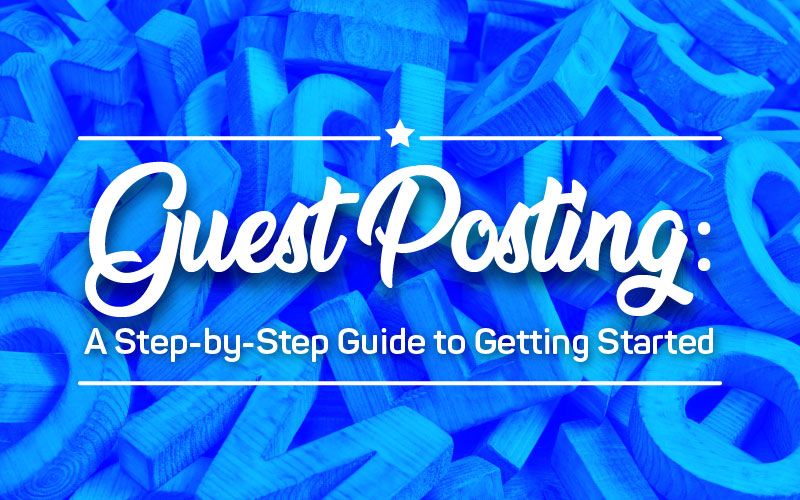The Complete Beginner's Guide to Guest Posting
This is the guide for you if you want to begin guest posting but aren't sure where to start. Learn how guest posting can help your business, as well as seven key steps for creating a strategy that supports your marketing goals, improves your brand's reach, and connects you with new consumers.
What Is Guest Posting and How Does It Work?

Contributing content to another person's or brand's website or blog is known as guest posting.
Guest blogging is another name for this strategy.
A writer serves as a contributor or guest author and contributes work to a publisher while guest blogging. In order to promote their marketing, PR, and SEO objectives, the writer contributes material to a site that does not belong to them or any of their businesses.
What Are the Advantages of Guest Posting?
Because it's a symbiotic relationship, guest blogging works effectively as a marketing strategy. It is advantageous to both publishers and authors.
Publishers acquire new material that their audience may enjoy and appreciate when the content is relevant, valuable, and high-quality.
For authors, there are several advantages to guest blogging:
Increases brand awareness
Establishes connections
Increases authority
reaches out to new people
Increases the number of visitors to their website
Increases the number of backlinks to a website. SEO
increases the size of their email list
Increases the number of followers on social media
In Seven Easy Steps, You Can Implement a Guest Posting Strategy
Developing an effective guest posting plan entails a number of phases. These phases assist you in laying a solid basis for your strategy by establishing clear goals, expectations, and criteria for determining which opportunities are the greatest fit for you.
The remainder of this article will show you how to:
Determine your objectives for guest posting.
Look for guest posting possibilities.
Sites for guest blogging that are of high quality
Topics for blog posts should be developed
Make the ideal pitch.
Write a post that is worthy of being published.
Maintain a record of your efforts.
Step 1: Establish Your Guest Posting Objectives
A effective guest posting plan, like all successful marketing tactics, begins with defining your objectives. Knowing what outcomes you desire from your job can help you plan out a clear path to get there.
Consider what you can accomplish with guest blogging and which two or three goals best line with your marketing goals.
Boost brand recognition. Increase the number of individuals who are aware of you and your brand.
Introduce yourself, your projects, and your services. Increase the number of individuals who are aware of what you have to offer.
Demonstrate how you can assist your audience. Increase the number of individuals who understand how your knowledge, goods, or services may help them solve issues.
Increase your social media presence. Increase the number of individuals who follow you or your brand on social media and connect with them.
Improve your search engine optimization. Obtain high-quality backlinks to aid your off-page SEO efforts.
Develop a reputation in the industry. To establish yourself as an industry authority, share your knowledge.
Increase the number of visitors. Drive more traffic to your website through referral traffic.
Increase leads. Generate more leads by reaching new audiences.
It will be easy to locate the greatest guest blogging possibilities once you know what you want your guest posting to accomplish. Prioritize sites that will assist you in achieving your objectives.
If you wanted to grow traffic, for example, you wouldn't want to spend time guest writing on a small specialized site with very little traffic. Writing for a tiny, industry-specific blog, on the other hand, may be beneficial if your objective is to establish industry authority.
Step 2: Look for Guest Post Opportunities
Use these two strategies to locate guest posting sites if you don't know where to look.
Look for Websites That Will Appeal to Your Audience
Begin by looking for websites that will appeal to and interest your target audience. Use a buyer persona template to develop a profile of your ideal consumer if you're not sure what your audience is interested in. Use Alexa's Audience Interest Tool to find out what topics your audience is interested in and which websites they frequent the most.
Enter your site or a site you know your target audience frequents. The program creates a list of categories that the site's visitors are interested in.
Find where your competitors post
Another way to find guest posting sites is to look at what sites already link to your competitors. If a site already links to your competitor, it is likely that they will link to your site as well.
Step 3: Select Guest Posting Sites that Meet Your Criteria
Start qualifying your possible guest posting sites once you've compiled a list. Look for sites that allow guest articles and are relevant to your strategy and objectives.
Create a list of criteria for guest posting that corresponds with your objectives and principles. Seek out websites that:
Have a clear idea of who you want to reach.
Have an idea of how big the audience you wish to reach is.
A specific volume of traffic must be driven.
Have a lot of search authority
To find metrics that can help you measure and qualify sites, use Alexa's Site Overview tool. To examine site stats, Alexa Rank, the number of connecting sites, traffic sources, audience demographics, and more, type in the URL of the target site.
Step 4: Brainstorm Blog Topic Ideas
It's time to come up with blog topics once you've found a site that meets your guest blogging requirements. Come up with a few post ideas that will help you achieve your goals while also catering to the publisher's and readers' demands and requirements.
Make sure it's appropriate for their audience.
Consider the publisher's target audience and create themes that are relevant to them.
Remember that you may use the Audience Interest Tool to determine which topics are most popular on a website.
Enter the site's URL to discover what its readers are interested in. To see clusters of subjects inside a category, click on it. Develop subjects that relate to the site's most popular categories from there.
Look for Any Content Gaps
Topics that have already been covered on a blog should not be pitched. Ideally, you'll offer concepts that address content shortages and needs. Examine the site and note any topics that would be a good match for it but have yet to be addressed.
Using Alexa's Competitor Keyword Matrix, you can quickly identify content gaps. Enter the target site as well as up to nine rivals. (Use the Audience Overlap Tool to locate the site's rivals if you don't know who they are.) For the target site, use the filter to "Show Keyword Gaps."
Make Sure the Topic Is Relevant to You and Your Objectives
While you want to make sure your topic is appropriate for the site and benefits the publisher's readership, bear in mind that it must also fulfill your own interests. Choose themes that will allow you to promote your passions, reference your industry, and connect with your target audience.
Step 5: Make a Pitch for a Guest Post
It's not as simple as submitting a guest article and getting it published on a publisher's site. Before your work can be considered for publication, you must first get the publisher's attention by pitching your piece.
To write a pitch for a guest post that will get noticed, follow these steps:
Locate the appropriate person to contact. Don't just go to a website's general contact page. See if you can identify the editor's or blog manager's name, then look for their contact information and contact them directly.
Look find and read the guest blogging guidelines on the site. Check to discover if there are any prerequisites for guest posting before you pitch. Don't waste your time (or the that of the publisher) pitching pieces that aren't likely to be approved.
Make a captivating topic line. Because you're probably not the only one pitching the publication, you'll want to stick out in their inbox. Instead of something generic and boring like "Guest Post Submission," write a subject line that is engaging and eye-catching.
Personalize your message, don’t promoting a product. You may be pitching hundreds of guest post opportunities, but that doesn't mean you should send the identical message to each one. As though you were writing a one-on-one email, write your outreach email.
Benefits should be the starting point. Tell the publisher what they'll get in return for their investment. Share what their visitors will gain and how the piece will improve their site to highlight the benefits of publishing your post. (To prove that you've done your homework and your post will cover a content gap on their site, include a screenshot of the Competitor Keyword Matrix in your posts.)
Include evidence of your worth and excellence. Include links to prior guest posts you've written, social media stats, and other details to demonstrate to the publication what you can provide and why they should collaborate with you.
Step 6: Create a Post That Is Worth Sharing
After your pitch has been accepted, you must compose a post that the publisher want to publish on their website. If you can deliver on your material, publishers will be more willing to publish your piece and deal with you again.
By following these best practices, you may submit a guest article that they will like.
Stick to the rules. First and foremost, if guest blogging rules and editorial standards are not supplied, request them and follow them.
Don't go overboard with the promotion. Even if your purpose for guest posting is to advertise your products and services, keep in mind that most publishers will reject pieces that are too promotional.
Write a bio that encourages people to discover more about you. Your author bio is another technique to get viewers back to your site. Include a link back to your site (if permitted) and a call to action to get readers to click for further information. To attract even more traffic, consider utilizing your bio to advertise a freebie or opt-in on your website.
Add value. Focus on adding value rather than being too promotional. You serve your readers by offering them something useful to take away while also boosting the likelihood that your article will be published by the publication.
Proofread. Repeat. Don't rely on publishers to determine whether or not your content is worthy of publication. To guarantee that it is clean and properly written, go through a few rounds of editing and proofreading.
If at all feasible, provide a link to a page on your own website in the blog post. The majority of publications have rules about linking in guest blogs. Follow their instructions and, if allowed, provide a link to a piece of material on your website. This aids in the return of relevant visitors to your site while also assisting with off-page SEO.
Step 7: Follow Up
Once you've submitted a guest article, your work isn't done. Follow up with the publication after your piece is published if you want to develop a solid connection with them and write for them again. Assist the publisher in promoting and managing the article.
Share your article on social media. Participate in blog marketing. By publishing about the information on your social media accounts, you may share it with your audience. Mention or link to the publisher's brand wherever feasible to demonstrate that you are striving to market your post.
Respond to any comments made. Keep an eye on your post's comments section. If they leave messages, respond as soon as possible.
Include a link to it on your site. Promote the piece on your site by including a link to it on a portfolio page or providing a summary of it on your own blog with a link to the original.
Subscribe to our newsletter here.

